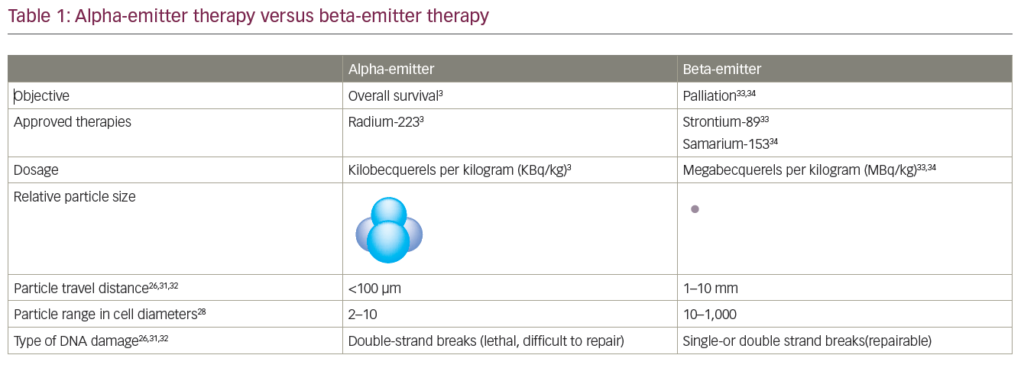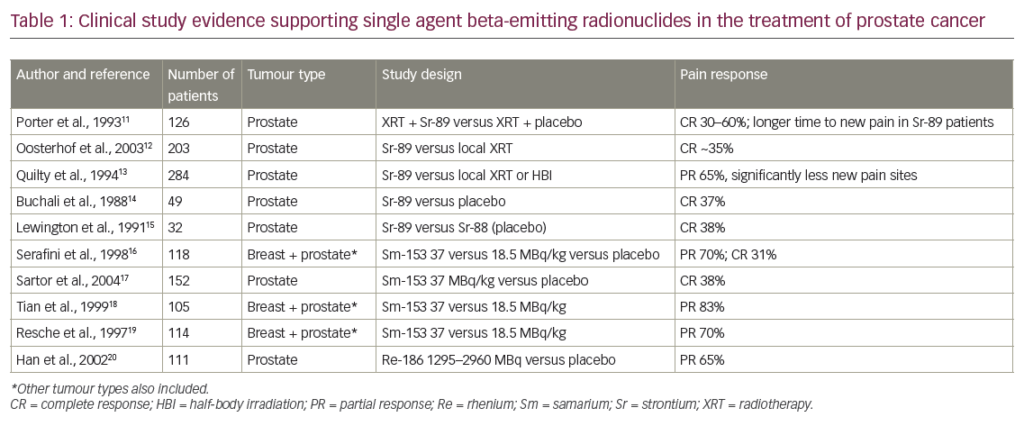Testosterone, the primary circulating androgen, is converted to its active form, alphadihydrotestosterone, by 5-alpha-reductase, and forms a complex with the dihydrotestosterone-binding domain of the androgen receptor. This complex then alters the structure of the DNA-binding domain allowing it to reversibly bind DNA sequences and androgen response elements in promoter or enhancer regions of androgenregulated genes. This response can be manifested as stimulation of cell division, inhibition of apoptosis, or cellular differentiation.
Androgen deprivation is one of the oldest treatments for adenocarcinoma of the prostate. Huggins won the 1966 Nobel Prize for Physiology and Medicine for reporting on the effects of androgen deprivation in men with adenocarcinoma of the prostate.1,2 Three effects have been noted when androgen deprivation is combined with radiation in the treatment of adenocarcinoma of the prostate:
• Androgen deprivation will result in tumor volume reduction that could enhance the response of radiation by decreasing the total number of viable clonogens.
• Androgen deprivation may eradicate tumor deposits outside of the radiation field.
• A supra-additive apoptotic effect has been reported in a human prostate cancer cell line when androgen ablation precedes a single fraction of radiation treatment by three days.3
Clinical Trials Evaluating Androgen Deprivation in Patients with Prostate Cancer
The Radiation Therapy Oncology Group (RTOG) has published numerous clinical trials investigating the addition of androgen suppression to radiation in the treatment of locally advanced prostate cancer. RTOG 75–06 was one of the first trials reporting on a possible survival benefit from the use of androgen suppression with radiation.4,5 This trial was designed to compare pelvic irradiation followed by a boost to the prostate with pelvic and periaortic irradiation followed by a boost to the prostate in the treatment of patients with clinical stage C adenocarcinoma with or without pelvic lymph node metastases, or patients with stage A2 and B disease with pelvic lymph node involvement. Patients were not randomized or stratified based upon hormone use, which could be either estrogen and/or orchiectomy. A disproportionally higher percentage of patients receiving hormone use had unfavorable lesions, but it appeared that hormones counteracted the effect of a higher proportion of histologically unfavorable lesions.5 A trend toward improved local control was also noted in patients receiving hormone therapy. Future RTOG clinical trials incorporating androgen suppression as a cytoreductive agent were designed based upon the results of RTOG 75–06.
RTOG 83–07, a phase II clinical trial,was designed to compare the efficacy and toxicity of megestrol acetate with diethylstilbestrol (DES). Hormones were given two months prior to and during radiation in the treatment of patients with bulky stage B (T2B) or Stage C (T3) adenocarcinoma.6 Patients received 44–46 Gray (Gy) to the regional lymphatics followed by a boost of 20–25Gy to the prostate target in 1.8–2.0Gy fractions. DES produced a statistically significant greater median decrease in testosterone compared with megestrol acetate; however, no difference was noted in primary tumor clearance at two years between study arms. Loco-regional recurrence was also comparable between arms at 16% versus 21% at seven years for megestrol acetate and DES respectively, with the rate of distant metastasis also not statistically different between the two arms. Because a clear-cut superiority was not documented between either drug, the RTOG became interested in using a luteinizing hormone-releasing hormone (LHRH), goserelin, and an anti-androgen, flutamide.
The relative effectiveness of adjuvant versus therapeutic androgen suppression was tested in RTOG 85–31. Patients with locally advanced adenocarcinoma of the prostate with regional lymph node involvement or clinical stage T3 disease were randomized to receive either goserelin started during the last week of radiation or at the time of relapse.7 Administration of the goserelin was given until a sign of relapse or indefinitely. Patients having undergone a radical prostatectomy were eligible if histologically documented penetration through the prostatic capsule to the margin of resection and/or seminal vesical involvement was noted pathologically. Updated results published by Lawton et al. in 2001 showed local failure at eight years was 23% in patients receiving adjuvant androgen suppression compared with 37% in patients treated with therapeutic androgen suppression, p<0.0001.8 Disease-free survival and biologic no evidence of disease (bNED) (defined as a prostate-specific antigen (PSA) of 1.5ng/ml) were both statistically significant in favor of patients receiving adjuvant androgen suppression.
Overall survival was not statistically significant between the two arms, but subset analysis showed patients with Gleason score 8–10 not undergoing radical prostatectomy did have a statistically significant improvement in both absolute and causespecific survival with adjuvant hormones.
Two randomized studies compared the addition of adjuvant androgen suppression to radiation with radiation alone in patients with locally advanced adenocarcinoma of the prostate. RTOG 86–10 compared goserelin, 3.6mg every four weeks, and flutamide, 250mg tid for two months, before and during radiation with radiation therapy alone, while the European Organization for Research and Treatment of Cancer (EORTC) performed a study comparing goserelin monthly on the first day of radiation and continuing for three years after the radiation. Patients receiving androgen suppression also received cyproterone acetate 150mg orally every day during the first month of radiation to prevent the transient rise in testosterone associated with the administration of goserelin.
The patient population differed slightly between the two trials. Patients treated on the RTOG trial had bulky T2–4 tumors with or without pelvic lymph node involvement, while the EORTC trial comprised of patients with World Health Organization (WHO) grade 3 T1–2 tumors or T3–4 N0–1 MO tumors. Patients treated with androgen suppression on RTOG 86–10 were found to have an improvement in local control, reduction in the incidence of distant metastases, improvement of disease-free and biochemical disease-free survival, and cause-specific mortality. Subset analysis found a highly significant improvement in patients with Gleason score 2–6 in all end-points including survival, but enhancement of local control or survival was not seen in patients with Gleason score 7–10.9 A statistically significant difference in survival was reported in patients treated on the EORTC trial, between those treated with androgen suppression and those receiving radiation alone. A significant improvement was found in fiveyear disease-specific and five-year overall survival as well as five-year clinical disease-free survival in patients treated with androgen suppression.10,11
The benefit of the addition of androgen suppression to radiation has been proven by the RTOG and EORTC trials, but the length of time of hormone suppression remains in question.The RTOG tried to address this question with RTOG 92–02. Patients with clinical stage T2c to T4 disease with no involved nodes in the common iliac or higher node chains and pre-treatment PSA levels less than 150ng/ml were eligible for randomization to receive monthly flutamide (250mg orally tid) and goserelin (3.6mg every month) until the completion of radiation and no further treatment (short-term androgen suppression), or to receive goserelin for an additional two years after the completion of the radiation (longterm androgen suppression). The radiation dose was the same in both arms; 44–46Gy to the regional lymphatics and up to 70Gy to the prostate.
A significant improvement in all efficacy end-points was found in patients treated with long-term androgen suppression except for overall survival.12 This differs from the EORTC trial where patients received three years of androgen suppression. Longterm androgen suppression did result in significantly better overall survival in a subset of patients with Gleason score 8–10 tumors.
D’Amico et al. have recently published the results of a randomized phase III study comparing the addition of six months of androgen suppression to threedimensional (3-D) conformal radiation with 3-D conformal radiation alone in the treatment of patients with a PSA >10ng/ml, or a Gleason score of at least seven, or radiographic evidence of extraprostatic disease. With a median follow-up of 4.52 years, patients randomized to receive androgen suppression had significantly higher survival, lower prostate cancer-specific mortality, and higher survival free of salvage androgen suppression therapy.13 This trial differed from the previously reported trials in the way the radiation dose was prescribed. The radiation dose in this trial was prescribed to a volume while the radiation dose in the previous trials was prescribed to a point within the prostate resulting in the patients in the D’Amico trial having a slightly higher dose delivered to the prostate. The question on the length of time to administer androgen suppression remains unanswered. Hopefully, a recently completed but unreported EORTC randomized trial comparing six months with three years of androgen suppression in addition to radiation will help answer this question.13 Toxicity and Cost Considerations
Increased toxicity has accompanied the beneficial effects seen with the addition of androgen suppression to radiation in the treatment of locally advanced prostate cancer. Megestrol acetate was found to be ‘less toxic’ in terms of fluid retention and gynecomastia, but cardiac problems and thromboembolic phenomena were not significantly different between megestrol acetate and DES.6 Twelve per cent of patients substituted orchiectomy for goserelin in the long-term hormone arm in RTOG 85–31.8 Only 94% completed goserelin treatment with 84% of patients randomized to receive androgen suppression treated on RTOG 86–10 completed flutamide as planned, with diarrhea and hot flushes being the major reasons for discontinuation of androgen suppression.9 A significant increase in late grade 3 gastrointestinal toxicity was noted in patients assigned to long-term androgen suppression in RTOG 92–02.12
Neoadjuvant androgen suppression was also associated with a significantly increased likelihood of grade 2 acute genitourinary complications in men treated on RTOG 94-06 with 3-D conformal radiation with poor baseline urinary function.14 Significantly more patients treated with androgen suppression had late grade 1–3 incontinence in the EORTC trial and 6% stopped the androgen suppression early because of toxicity or patients’ wishes.10,11 A significant increase in impotence and gynecomastia was also noted in men receiving six months of androgen suppression compared with men only receiving radiation in the trial recently reported by D’Amico.13
In addition, androgen suppression can also result in decreased quality of life.A recent study comparing 79 men receiving androgen suppression with 65 men not receiving androgen suppression found fatigue, emotional distress, and decreased physical functioning in the patients receiving androgen suppression.15 Utilities or preferences for different health states is also lower in men receiving androgen suppression with radiation compared with men only receiving radiation.16 Long-term androgen suppression might also result in an increased risk of osteoporosis.17, 18
Neymark et al. found the combination of androgen suppression and radiation to be cost-effective after performing an economic analysis of patients treated on the EORTC trial. Costs were collected from patients treated at one of the participating hospitals. They found androgen suppression and radiation increased mean survival by about one year while reducing the costs per patients for the French health insurance system by 12,700 French Francs.19 Investigators from the RTOG, using a Markov model, have also found similar results. The model was constructed using clinical data from RTOG 86–10 with cost and utility data obtained from the literature to inform the Markov model. Androgen suppression resulted in a mean increase of approximately one quality-adjusted life year with a total cost of care increase of US$2,046.20
Conclusion
Androgen suppression has been shown in randomized clinical trials, both in the pre-PSA and PSA eras, to provide not only a bNED, but an overall survival benefit. However, it has been associated with increased gastrointestinal and genitourinary toxicity. Economic analysis in Europe and the US has found that despite its decrease in quality of life, androgen suppression is a cost-effective treatment of patients with locally advanced adenocarcinoma of the prostate.












